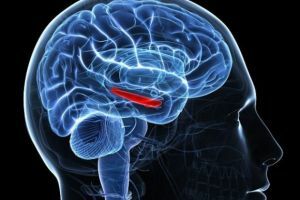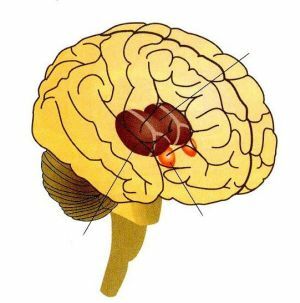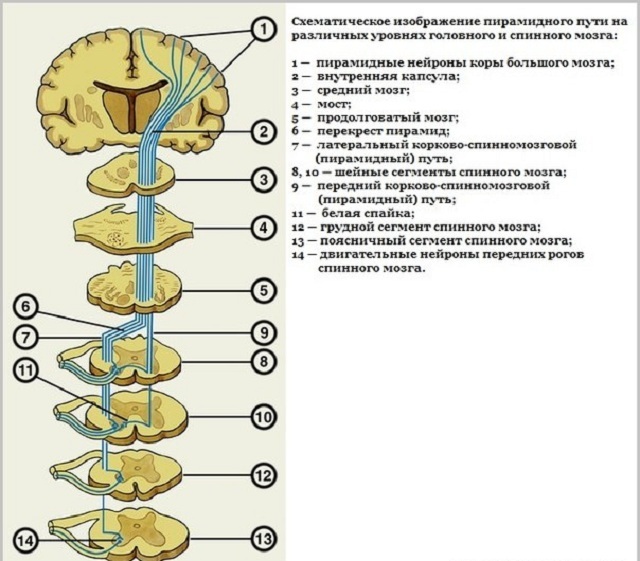 Diencephalic syndrome( hypothalamic) is a complex of disorders of the endocrine, metabolic, vegetative type.
Diencephalic syndrome( hypothalamic) is a complex of disorders of the endocrine, metabolic, vegetative type.
During these disorders, the hypothalamic region of the midbrain is affected. In most cases, these disorders are due to hypothalamic dysfunction.
For the diencephalic syndrome is characteristic:
- change in body weight, in most cases it increases;
- occurrence of headaches;
- problems with mood, frequent changes;
- appearance of hypertension;
- problems with the menstrual cycle;
- increased appetite;
- occurrence of a sensation of increased thirst;
- sometimes increases and decreases sexual desire.
This disorder often occurs in the endocrinological, gynecological, neuralgic practice, while at the time of diagnosis there are difficulties that are associated with a variety of symptoms and varieties of the syndrome.
Diencephalic syndrome in most cases occurs in adolescents aged 13 to 15 years, as well as during the reproductive age of 31 to 40 years. In the reproductive age, it mainly prevails in women - from 12.5% to 17.5%.
The disease leads to serious reproductive disorders in many women. There is a development of endocrine infertility, the appearance of polycystic ovaries, as well as various obstetric and perinatal pathologies.
Causes and provoking factors
Disturbances in the functioning of the hypothalamus can arise due to a number of reasons and factors: 
- the presence of tumors in the brain of , which lead to compression of the hypothalamic region;
- traumatic brain injury , during which direct damage to the hypothalamus occurs;
- state of neurointoxication - substance abuse, drug addiction, alcoholism, harm from production activities, the effect of environmental harmful components;
- various disorders with vascular character - stroke, osteochondrosis;
- of neuroinfection of viral and bacterial type - influenza, malaria, tonsillitis in chronic form;
- factors with psychogenic character - manifestation of stress and shock situations, excessive mental stress;
- gestation period and hormonal changes that are associated with this period;
- diseases of a chronic type that manifest themselves together with elements of the vegetative type - bronchial asthma, the state of hypertension, ulcerous lesions of the stomach and duodenum, the state of obesity.
Classification and clinical picture of
There are a large number of research programs on the study of the diencephalic syndrome, according to which a classification of the disorder was created.
Dysfunction of diencephalic structures can be of several types, each with its own symptoms and manifestations:
- Diancephalic syndrome with hypothalamic( diencephalic) epilepsy .
- Disorder of vegetative-visceral-vascular nature .There are violations in the cardiovascular and respiratory system.
- The disorder of thermoregulation .There is an increase in body temperature from subfebrile to febrile. With this form of
 , a state of chills, muscle yeast, and sometimes hypothermia may appear.
, a state of chills, muscle yeast, and sometimes hypothermia may appear. - Neuromuscular disorders of the .This form is accompanied by increased weakness in the form of physical asthenia.
- Nervous-trophic disorders of the .This disorder is characterized by the manifestation of increased edema on the background of general weakness, thirst, headaches, oznobipodobnogo tremor and hypothermia.
- Neuroendocrine form of .This disorder manifests itself in the form of hypo- and hyperfunction of the pituitary gland and other endocrine glands.
- Neuropsychiatric disorders .There are vegetative-vascular, neuroendocrine, metabolic-trophic disorders.
- Neuroendocrine-metabolic disorders .These are endocrine disorders, which cause obesity, early puberty, headaches, there is rapid physical and mental fatigue, menstrual irregularities and other disruptions.
Diancephal epilepsy
Diencephalic epilepsy is a kind of vegetative paroxysm, similar to the attacks of ordinary epilepsy, but the cause of which are disorders in the hypothalamus. They can occur from a few hours to a day.
This form of the syndrome combines the following symptoms:
- a day before the onset of an attack a person can change their mood;
- occurrence of increased hunger;
- sensation of thirst;
- manifestation of causeless fear;
- approximately in two hours there can be a sensation of a cold fit;
- increased body temperature;
- manifestations of severe sweating;
- can change the color of the skin;
- occurrence of frequent urination and defecation.
Seizures usually occur in conjunction with convulsions, fainting.
Diagnosis is not an easy task
During a polymorphic diagnosis of a diencephalic syndrome, it may be difficult to examine a patient. In order to diagnose, such studies are conducted and the following tests are taken: 
- carrying out a sugar curve;
- result of thermometry in three places;
- EEG;
- takes a three-day trial of Zimnitsky.
Fasting glucose is determined with a sugar loading level of 100 grams. At the same time, the glucose value is determined every half hour.
A number of varieties of the sugar curve are defined:
- of the hyperglycemic type , when the glucose value exceeds the normal level;
- of the hypoglycemic type , when the glucose is below the normal level;
- two-humped type , when the drop in the glucose value changes with a new increase;
- torpid type, when a small jump in the blood glucose level stops at the same level.
Thermometry is done in three zones - in two armpits and in the rectum area. Various disorders with a thermometric character can manifest as isothermia, when the temperature regime in the axillary region and in the rectum are equal, while the temperature level in the rectum should be higher by 0.5-1 degrees Celsius.
And also in the form of hypo- and hyperthermia( in the underarm region, the temperature regime is higher or lower than the norm), therominfusion, when the level of temperature in the rectal zone is below the temperature regime of the axillary zone.
 During the electroencephalographic study, it is possible to identify problems that concern the deep structure of the brain.
During the electroencephalographic study, it is possible to identify problems that concern the deep structure of the brain.
When taking a three-day trial of Zimnitsky, studies are being done to help determine the level of liquids discharged and emitted.
In addition, an MRI of the brain is performed, which helps to determine high intracranial pressure, as well as the various consequences of traumatic injuries, hypoxia, tumoral formations.
Studies are conducted on the level of hormones in the blood and the biochemical data of the blood composition is determined, this is necessary to determine the endocrine-metabolic disorders.
In order to determine the syndrome with organic origin, a number of studies are performed:
- of the adrenal ultrasound;
- ultrasound of the thyroid gland and internal organs;
- MRI and CT of the adrenal glands.
Complex of medical procedures
For diagnosis and subsequent treatment it is necessary to contact the following specialists - endocrinologist, neurologist and gynecologist for women.
The selection of treatment methods for each patient is strictly individual. The main goal of treating the diencephalic syndrome is to correct the disturbances and normalize the hypothalamic structures of the brain.
At the beginning of the therapy factors of etiological type are eliminated. Purification of infectious foci is done, traumatic injuries, tumors are treated.
In case of intoxication with alcoholic beverages, drugs, insecticides, pesticides, heavy metals, it is necessary to provide active therapeutic treatment of detoxification type, during which intravenous injections are made with Haemodesum, Sodium thiosulfate, Glucose, physiological saline.
For the purpose of relief of exacerbations of sympathetic-adrenal type syndrome, it is necessary to use pyrroxane, Bellataminal, Eglonil, grandaxin, antidepressants.
During neuroendocrine disorders, correction therapy is prescribed, during which it is necessary to apply hormonal medications with a substitute, stimulating or inhibitory type. And also the observance of dietary nutrition and the reception of regulators with neurotransmitter exchange( Bromocriptine, Diphenin) for up to 6 months is prescribed. 
To improve brain activity, the use of Piracetam, Cerebrolysin, Cavinton, B vitamins, amino acids( Actovegin, Glycine), calcium preparations is prescribed.
Also used reflexotherapy, physiological procedures, therapeutic gymnastics.
Due to the fact that the symptoms of the hypothalamic syndrome can be manifested as a result of changing weather conditions, due to severe irritation or physical overstrain, it is necessary to take sedative medications, antidepressants, tranquilizers in order to prevent this disorder.
In addition, you should avoid stress, nervous overexertion and rest on time.



